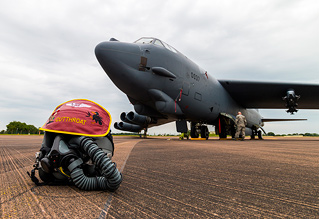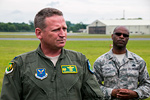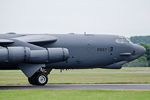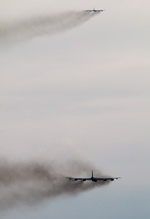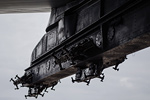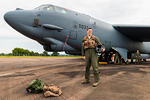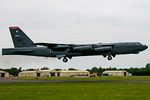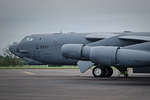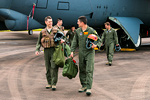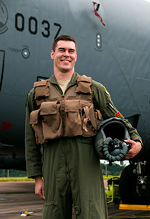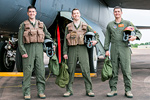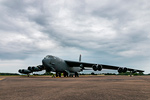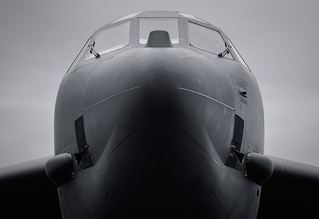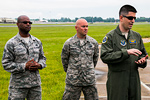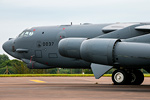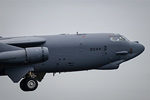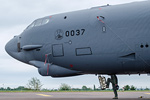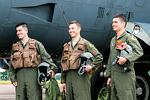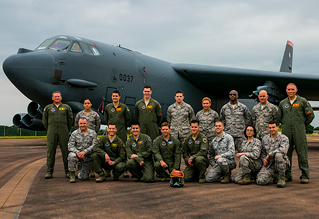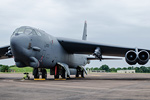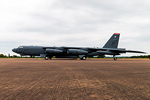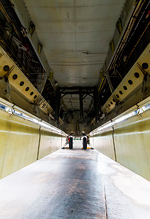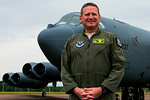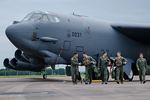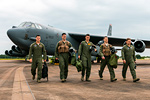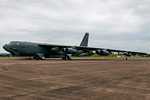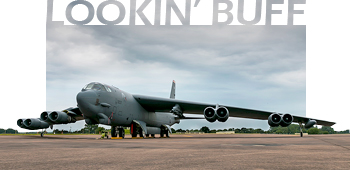
RAF Fairford BALTOPS/Exercise Saber Strike
Saturday 11th June 2016
For the third successive year, RAF Fairford in Gloucestershire once again became a hive of activity at the end of May as the base played host to the monstrous Boeing B-52H Stratofortresses, this time from the 23rd "Bomber Barons" Bomb Squadron of the 5th Bomb Wing based at Minot AFB of the US Air Force's Global Strike Command.
reports on the "BUFF"'s return to that most hallowed of Gloucestershire turf. Additional photography from .
For a while, the much-loved mighty big ugly fat fellas ("BUFFs") had become relatively rare sights in Europe, it is a welcome sight and indeed sound, to have the machines appear again with some regularity in the UK in recent years.
This year marks a continuation of yearly bomber deployments to RAF Fairford which started in June 2014. Present in 2016 were three machines from Minot Air Force Base in North Dakota. The aircraft were principally deployed to support two major European exercises which take place at this time of year; BALTOPS, and Exercise Saber Strike.
BALTOPS is the premier maritime exercise in the Baltic Sea region, and involves a vast number of NATO countries - allowing the crews of the B-52Hs to work with these different nations and military arms. Furthermore, by its nature, BALTOPS being a maritime exercise presents some more irregular scenarios and training for the USAF bomber crews. Using the B-52 in a maritime capacity stretches the legs of these already exceptionally competent machines in terms of their capability.
Indeed - as an example - whilst media were present, two of the three machines departed RAF Fairford in the early afternoon equipped with six dummy Mk-62 Quickstrike Mines. Despite only carrying six for the purposes of the exercise, the BUFFs can carry up to twenty-seven of the Mk-62s internally, with an additional eighteen on external pylons representing an impressive complement of weaponry for one sortie.
Dropping mines represents a number of training opportunities for the crews; as Lt. Col. Maginness explained, the Mk-62s are not precision guided, and fall balistically without guidance. This in turn creates very tight navigational tolerances for the crews, as deviation by as little as a single degree at the start of a mine-laying run could result in the mines dropped at the end of the run being some way off-target. Being based in the Upper Midwestern region, the Minot AFB crews seldom have the opportunity to drop mines in the US, so their deployment to Europe allowed them the opportunity to practice operations which might not be considered regular to them. The dropping of mines also doubles-up to provide useful training to naval arms in the recovery of the dummy ordinance.
Exercise Saber Strike is a massive multi-national land-based exercise taking place in Estonia, Latvia and Lithuania, involving circa 10,000 personnel and featuring participation in some way or another from almost every single NATO country. Exercise Saber Strike has been conducted annually since 2010. Principally, the B-52 crews enjoy the challenges faced from working with JTACs from different nations, in particular forces where English is not the first spoken language. Indeed, the integration of close-air support (CAS) was a key feature of this year's exercise.
The B-52s themselves remain both potent and impressive platforms. Each aircraft has five officer crew members; including a pilot, co-pilot, electronic warfare officer, radar navigator (conventionally known as the bombardier), and a navigator. Progressing their capability well into the 21st century, the B-52s are now equipped with the advanced Sniper and Litening targeting pods; and indeed, targeting pods are being used on almost every mission flown, which allows the crews to perform what is known as NTSR ("Non-Traditional Search and Reconnaissance"). In addition to making good use of their targeting pods, the B-52's electronic countermeasures suite is put to use, allowing crews to test their defensive capabilities.
The operational tempo of a mission starts 24 hours before a sortie, where a crew working under Maj. Fredo Devida - the 23rd Expeditionary Bomb Squadron Commander - forms a mission cell, planning their sorties and packages, deconflicting with other aircraft flying on the exercise, and agreeing on a common set of rules to follow in order to train safely and professionally.
Whilst working in support of both BALTOPS and Ex. Saber Strike, and training alongside the likes of RAF Mildenhall-based KC-135s, Luftwaffe Typhoons, Polish Air Force F-16s, and Swedish JAS-39 Gripens; the B-52s working with the Combined Ops Centre in Germany will frequently participate in both exercises during the same sortie, and will regularly end up integrating with up to 17 different nations, across differing time-zones. For the B-52 crews, participating in two separate exercises is not necessarily difficult. Every mission flown is considered to be a swing-role mission, and 8-10 hour sorties are not considered "long" sorties by crews that are used to regularly training on sorties of over 24 hours duration. Though the B-52 crews train with those of the 100th ARW at RAF Mildenhall, on sorties in support of BALTOPS and/or Saber Strike the B-52s seldom require air-to-air refuelling as a necessity in order for them to complete their mission.
Chief Master Sgt. Turner described things from a maintenance point of view; the crews have three machines at their disposal on this year's deployment, and the best two will always be used. Standard procedure has an aircraft land, and the aircrew debrief the ground crew on how the aircraft performed, and whether there were any in-flight issues. Using this information, the ground crews will examine the machines, determine their status, and make an assessment of whether the particular airframe is mission-capable or not. Those machines that are mission capable will be refuelled in accordance with their next mission requirements and undergo standard pre-flight checks.
It is hoped that the machines return with a status of "out for one", which reveals no significant mechanical issues, with only a refuel and a basic inspection needed, allowing for a very quick turnaround. When mechanical issues become more complicated, maintenance periods can be anywhere up to 24 hours, depending on the nature of the problem. Staff Sgt. Spencer, the premier Crew Chief, reminded those present that the B-52s were not young machines, and whilst their out of service date ("OSD") is currently touted to be 2040 (staggeringly, nearly 90 years since the type's first flight), they are unsurprisingly not problem-free.
Three months prior to the deployment crews are informed and preparations get underway, including the creation of a maintenance footprint, and how many machines are needed. Logistically, when tasked to deploy to RAF Fairford, the 5th Bomb Wing have a mobility section, who go to USAF Global Strike Command, who in turn speak to those at RAF Fairford, listing the requirements for the deployment dependant on the number of aircraft and personnel to be deployed. RAF Fairford personnel check on reserves of equipment stored on base, and anything that RAF Fairford does not have is sourced from larger bases, such as RAF Mildenhall. If a particular piece of equipment still cannot be sourced, then the crews from Minot AFB bring it with them for the deployment. In this particular instance, crews used two support aircraft to bring equipment from Minot AFB to RAF Fairford. Naturally, crews have a good idea of their "high-failure" items, and ensure that sufficient spares are sourced. In terms of personnel, the maintenance crews are from Minot AFB but logistical crews, such as the refuelling team, are sourced from nearby RAF Mildenhall.
Col. Kieran Denehan was deployed with the 23rd Bomb Squadron and was on his last days operating the mighty B-52. Acting as an overseer on the exercise, Col. Denehan - a B-52 senior navigator - will perform his final flight in the B-52 as he guides one of the three machines home to Minot AFB before being transferred to a non-flying role within the US Air Force.
Unexpectedly, the crews have been lucky enough to participate at a handful airshows whilst deployed to the European theatre. Besides being a morale booster for crews, they are able to work it into their training missions - with added practice in navigating and familiarising themselves with the UK and Europe's complex and, at times, congested airspace.
The Boeing B-52 - now designated the B-52H - has been in service for over 61 years and, despite its age, remains at the bleeding edge of the USAF Global Strike Command's reach; their annual deployments to the UK in support of European exercises ensure that the Stratofortress and those who fly them remain at the apex of capability offered by the mighty machines.
We would like to extend our gratitude and thanks to SrA Sahara Fales/5th BW PA, to the men and women of RAF Fairford and the 23rd Expeditionary Bomb Squadron for their help and hospitality.

